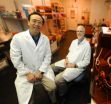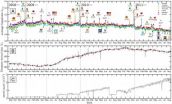(Press-News.org) VIDEO:
Brown engineers have devised an automated system that combines chemical precipitation with electrolytic techniques in a cyclic fashion to remove mixtures of trace heavy metals from contaminated water.
Click here for more information.
PROVIDENCE, R.I. [Brown University] — An unfortunate consequence of many industrial and manufacturing practices, from textile factories to metalworking operations, is the release of heavy metals in waterways. Those metals can remain for decades, even centuries, in low but still dangerous concentrations.
Ridding water of trace metals "is really hard to do," said Joseph Calo, professor emeritus of engineering who maintains an active laboratory at Brown. He noted the cost, inefficiency, and time needed for such efforts. "It's like trying to put the genie back in the bottle."
That may be changing. Calo and other engineers at Brown describe a novel method that collates trace heavy metals in water by increasing their concentration so that a proven metal-removal technique can take over. In a series of experiments, the engineers report the method, called the cyclic electrowinning/precipitation (CEP) system, removes up to 99 percent of copper, cadmium, and nickel, returning the contaminated water to federally accepted standards of cleanliness. The automated CEP system is scalable as well, Calo said, so it has viable commercial potential, especially in the environmental remediation and metal recovery fields. The system's mechanics and results are described in a paper published in the Chemical Engineering Journal.
A proven technique for removing heavy metals from water is through the reduction of heavy metal ions from an electrolyte. While the technique has various names, such as electrowinning, electrolytic removal/recovery or electroextraction, it all works the same way, by using an electrical current to transform positively charged metal ions (cations) into a stable, solid state where they can be easily separated from the water and removed. The main drawback to this technique is that there must be a high-enough concentration of metal cations in the water for it to be effective; if the cation concentration is too low — roughly less than 100 parts per million — the current efficiency becomes too low and the current acts on more than the heavy metal ions.
Another way to remove metals is through simple chemistry. The technique involves using hydroxides and sulfides to precipitate the metal ions from the water, so they form solids. The solids, however, constitute a toxic sludge, and there is no good way to deal with it. Landfills generally won't take it, and letting it sit in settling ponds is toxic and environmentally unsound. "Nobody wants it, because it's a huge liability," Calo said.
The dilemma, then, is how to remove the metals efficiently without creating an unhealthy byproduct. Calo and his co-authors, postdoctoral researcher Pengpeng Grimshaw and George Hradil, who earned his doctorate at Brown and is now an adjunct professor, combined the two techniques to form a closed-loop system. "We said, 'Let's use the attractive features of both methods by combining them in a cyclic process,'" Calo said.
It took a few years to build and develop the system. In the paper, the authors describe how it works. The CEP system involves two main units, one to concentrate the cations and another to turn them into stable, solid-state metals and remove them. In the first stage, the metal-laden water is fed into a tank in which an acid (sulfuric acid) or base (sodium hydroxide) is added to change the water's pH, effectively separating the water molecules from the metal precipitate, which settles at the bottom. The "clear" water is siphoned off, and more contaminated water is brought in. The pH swing is applied again, first redissolving the precipitate and then reprecipitating all the metal, increasing the metal concentration each time. This process is repeated until the concentration of the metal cations in the solution has reached a point at which electrowinning can be efficiently employed.
When that point is reached, the solution is sent to a second device, called a spouted particulate electrode (SPE). This is where the electrowinning takes place, and the metal cations are chemically changed to stable metal solids so they can be easily removed. The engineers used an SPE developed by Hradil, a senior research engineer at Technic Inc., located in Cranston, R.I. The cleaner water is returned to the precipitation tank, where metal ions can be precipitated once again. Further cleaned, the supernatant water is sent to another reservoir, where additional processes may be employed to further lower the metal ion concentration levels. These processes can be repeated in an automated, cyclic fashion as many times as necessary to achieve the desired performance, such as to federal drinking water standards.
In experiments, the engineers tested the CEP system with cadmium, copper, and nickel, individually and with water containing all three metals. The results showed cadmium, copper, and nickel were lowered to 1.50, 0.23 and 0.37 parts per million (ppm), respectively — near or below maximum contaminant levels established by the Environmental Protection Agency. The sludge is continuously formed and redissolved within the system so that none is left as an environmental contaminant.
"This approach produces very large volume reductions from the original contaminated water by electrochemical reduction of the ions to zero-valent metal on the surfaces of the cathodic particles," the authors write. "For an initial 10 ppm ion concentration of the metals considered, the volume reduction is on the order of 106."
Calo said the approach can be used for other heavy metals, such as lead, mercury, and tin. The researchers are currently testing the system with samples contaminated with heavy metals and other substances, such as sediment, to confirm its operation.
###The research was funded by the National Institute of Environmental Health Sciences, a branch of the National Institutes of Health, through the Brown University Superfund Research Program.
Novel device removes heavy metals from water
2011-12-19
ELSE PRESS RELEASES FROM THIS DATE:
UCSF-led team discovers cause of rare disease
2011-12-19
A large, international team of researchers led by scientists at the University of California, San Francisco has identified the gene that causes a rare childhood neurological disorder called PKD/IC, or "paroxysmal kinesigenic dyskinesia with infantile convulsions," a cause of epilepsy in babies and movement disorders in older children.
The study involved clinics in cities as far flung as Tokyo, New York, London and Istanbul and may improve the ability of doctors to diagnose PKD/IC, and it may shed light on other movement disorders, like Parkinson's disease.
The culprit ...
New Geology science posted online Dec. 8-16 2011
2011-12-19
Boulder, Colo., USA – GEOLOGY topics include an explanation for missing mid-Cenezoic sediments discovered in Lomonosov Ridge drilling; understanding position shifts of the Intertropical Convergence Zone; an analysis decoupling taxonomic and ecological severities of major mass extinctions; a Pleistocene reversal of British Columbia's Fraser River; quality comparison of land and sea fossil records; evidence of a large drop in the Gulf of Mexico's sea surface temperatures before major growth of the Antarctic ice sheet, and more.
Highlights are provided below. Representatives ...
Scientists may be able to double efficacy of radiation therapy
2011-12-19
AUGUSTA, Ga. – Scientists may have a way to double the efficacy and reduce the side effects of radiation therapy.
Georgia Health Sciences University scientists have devised a way to reduce lung cancer cells' ability to repair the lethal double-strand DNA breaks caused by radiation therapy.
"Radiation is a great therapy – the problem is the side effects," said Dr. William S. Dynan, biochemist and Associate Director of Research and Chief, Nanomedicine and Gene Regulation at the GHSU Institute of Molecular Medicine and Genetics. "We think this is a way to get the same amount ...
Country Singing Starlet Lizzie Sider Featured on Kings of A&R Website
2011-12-19
Young country crooner, Lizzie Sider, is a fresh talent that continues to gain well-deserved recognition for her musical ability, and is now featured on the Kings of A & R website!
Having already performed with country music star Jamie O'Neal and recorded music with some of the top names in the industry, Lizzie Sider is the name on everyone's lips, being talked about for her natural singing talents and unmistakable down-to-earth charm. Lizzie brings an original sound to the table, injecting her music with her unique take on songwriting and her strong, beautiful vocal ...
Invito Couture Launches Online Shopping Website
2011-12-19
The Invito Couture boutique of Vancouver, Canada, is pleased to announce that their entire collection of evening gowns and cocktail dresses can now be purchased online from their website, http://www.invitocouture.com. Invito Couture offers over 70 exclusive styles of high-quality dresses and gowns at affordable prices. All dresses are Italian-designed and made in Turkey.
Since opening in 2009, Invito Couture's dresses were only available to shoppers who visited their boutique in Vancouver but now with the launch of the Online Shopping section of their website, shoppers ...
GDP up, happiness down
2011-12-19
The gross domestic product of the United States -- that oft-cited measure of economic health -- has been ticking upward for the last two years.
But what would you see if you could see a graph of gross domestic happiness?
A team of scientists from the University of Vermont have made such a graph -- and the trend is down.
Reporting in the Dec. 7 issue of the journal PLoS ONE, the team writes, "After a gradual upward trend that ran from January to April, 2009, the overall time series has shown a gradual downward trend, accelerating somewhat over the first half of 2011."
"It ...
BizyGlobe.com - Worldwide Local Business Directory Local Business Directory - A cost-efficient marketing tool for small businesses worldwide.
2011-12-19
Today's modern business is very competitive and its promotion to a wider customer base is a tough task. However modern internet based technologies and marketing strategies are a great help and made it easier to promote a business product or service to a wider customer base efficiently and cost-effectively. A business service or product promoted in a global view would attract a higher customer attention thus increasing the customer base for a business. Larger the customer base higher the business growth.
To tap into a wider customer base or enter into a global market, ...
UC Irvine researchers urge caution when buying noisy toys
2011-12-19
Orange, Calif., Dec. 16, 2011 — While Road Rippers Lightning Rods, Let's Rock Elmo and the I Am T-Pain musical microphone might be sought-after gifts this holiday season, parents should ensure that their children don't risk permanent hearing damage by misusing them.
Researchers from UC Irvine's Department of Otolaryngology measured the noise levels of two dozen popular toys in stores and purchased the 10 loudest for precise gauging in a soundproof booth at UC Irvine Medical Center. They found that all exceeded 90 decibels and several reached 100 or more, equivalent to ...
Finding Drama-Free Love in 2012 Keynotes Singles Convention
2011-12-19
Author Susan Bradley is the Keynote Speaker at a Singles Convention, Friday, January 6, 2012, 7:30pm, at Servino's Ristorante, 9 Main Street, Tiburon CA 94920. Her topic is "Finding Drama-Free Love in 2012." DANCE PARTY follows, featuring current hits and oldies.
"The Number One New Years Resolution for singles is to find a happy romantic relationship," says Ms. Bradley, founder and director of LovingUniversity.com. "The key to a happy relationship is that it be drama-free. Unfortunately, many singles are addicted to drama and repeatedly choose ...
Caterpillars mimic one another for survival
2011-12-19
In the world of insects, high risk of attack has led to the development of camouflage as a means for survival, especially in the larval stage. One caterpillar may look like a stick, while another disguises itself as bird droppings. Though crypsis may have its advantages, University of Florida researchers uncovered some of the most extensive evidence of caterpillars using another strategy previously best-known in adult butterflies: mimicry.
Insects use camouflage to protect themselves by looking like inanimate or inedible objects, while mimicry involves one species evolving ...


